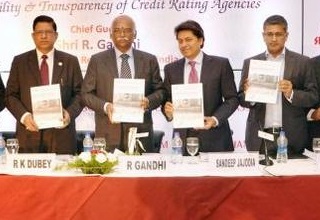
New Delhi, Jun 2 (KNN) One segment which particularly becomes vulnerable to economic shocks is the SME segment, said RBI adding that they are disadvantaged on account of their size and also are the first ones to get affected when downturn takes place.
Addressing a conference conducted by ASSOCHAM, RBI Deputy Governor, R Gandhi said, “CRAs (Credit Rating Agencies) have models in place for rating of SMEs and the NSIC scheme gives a subsidy to SMEs for the rating.
The conference focussed on the Growing NPAs in Banks: Efficacy of Ratings Accountability and Transparency of Credit Rating Agencies.
“It will be a good idea for banks to require a rating from these SMEs before giving a loan so that there is a check in place before the loan is disbursed.
“Given the large number of SMEs in our space, it may not be possible for banks to do a due diligence for one and all. This is where the systems organized by CRAs can be harnessed by banks so that there is some homework already done which is useful for banks,” he added.
While speaking on how to merge banks credit appraisals and CRAs’ assessments, Gandhi said, “There are essentially four issues here where banks and CRAs need to work together which will also help banks to de-risk their own portfolios as well as monitor their loans more effectively.”
The first issue he said is, “Indian banks in conformity with the Basel II norms have been extensively using the credit assessment opinion of external rating agencies for calculating risk based capital requirements. Even though banks do not require credit rating by external rating agencies for calculating their capital requirement for all loans (only loans above Rs 10 crore require credit rating), some are seemed to be asking companies to get a rating.”
Second, I do see a lot of use in the products offered by CRAs and there is need to see how we can further integrate the two models of credit risk assessment of banks and CRAs. There is a suggestion that banks should de-risk their own portfolio by asking companies looking for long term finance to partly borrow from the corporate debt market, Gandhi added.
Thirdly, one segment which particularly becomes vulnerable to economic shocks is the SME segment. They are disadvantaged on account of their size and also are the first ones to get affected when the downturn takes place.
Fourth, as you may be aware, recently we have given guidelines on banks offering credit enhancement on infra bonds issued subject to certain conditions. This is definitely one measure that we would like to pursue which will also work towards developing the bond market, he said.
On the accountability of CRAs, RBI Deputy Governor said, “There are two conventional models. These are: ‘investor-pay’ model, where the investor or banker commissions the credit rating and ‘issuer-pay’ model, where the issuer of the security or borrower pays for the rating. Of late, a new model is being proposed: ‘society-pay’ model, where a neutral third party, i.e., Government, Regulator etc., pays for the rating of a debt.”
On the growing number of Non-Performing Assets (NPAs), Gandhi said, “Growing NPAs is the biggest challenge for the banking industry. A slowing economy is bound to see an increase in NPAs. Notwithstanding the economic weakness, the NPAs of banks have registered increases since FY 2012 which is a cause of concern for us.”
The NPA increases have been more pronounced in case of the public sector banks. There are various factors affecting the asset quality of SCBs adversely, such as the current slowdown- global and domestic, persistent policy logjams, delayed clearances of various projects, aggressive expansion by corporate during the high growth phase etc.
However, it is the shortcomings in the credit appraisal, disbursal and recovery mechanism of the banks, besides the economic slowdown that can in large part be held responsible for their high levels of NPAs. Lack of robust verification and screening of application, absence of supervision following credit disbursal and shortfalls in the recovery mechanism have led to the deterioration of asset quality of these banks, Gandhi added.